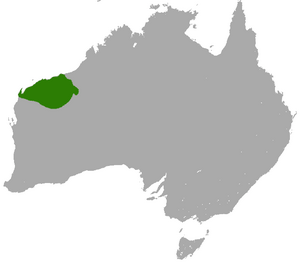Pilbara ningaui facts for kids
Quick facts for kids Pilbara ningaui |
|
|---|---|
| Conservation status | |
| Scientific classification | |
 |
|
| Pilbara ningaui range |
The Pilbara ningaui (Ningaui timealeyi) is a super tiny marsupial that lives in Australia. It's also known as Ealey's ningaui. This little animal is a carnivore, meaning it eats other small creatures.
Contents
Discovering the Pilbara Ningaui
Scientists gave the Pilbara ningaui its official name, Ningaui timealeyi. This happened in 1975, thanks to a scientist named Mike Archer. He studied this animal and realized it was a new type of marsupial.
The first special example of this animal, called a holotype, was found in 1963. It was collected by A. Snell after it escaped a fire in a grassy area in northwest Australia. Another important specimen was found in 1957 by E. H. M. Ealey. He worked for the CSIRO. The ningaui's scientific name, timealeyi, honors Ealey, whose nickname was 'Tim'.
What Does a Pilbara Ningaui Look Like?
The Pilbara ningaui is one of the smallest marsupials in the world! It's even smaller than some of the tiny planigales.
- Size: Its body is only about 4.5 to 5.8 centimeters (about 2 inches) long.
- Tail: Its tail is a bit longer than its body, usually 6 to 7.6 centimeters (about 2.5 to 3 inches).
- Weight: It weighs only about 5 to 9.4 grams. That's lighter than a few coins!
- Fur: Its fur looks spiky and a bit messy. It's a mix of ginger and brown, or grey-brown. The sides of its body, ears, and face often have a reddish-brown color.
- Face: It has a long, pointy nose and eyes that are set close together.
Female Pilbara ningauis have six teats, which is fewer than other types of ningauis.
Where Do Pilbara Ningauis Live?
This tiny marsupial lives in Western Australia. You can find it in the Pilbara and Gascoyne regions. It also lives in parts of the Little Sandy Desert.
Even though they are small, Pilbara ningauis can be quite common in some places, like the Hamersley Range. However, you won't often find them outside of these specific areas. They like to live in dense undergrowth.
Pilbara Ningaui Behaviour and Life Cycle
The Pilbara ningaui is partly arboreal. This means it spends some of its time climbing in trees and bushes. It likes to look for food in thick plants close to the ground.
Their breeding season depends on how much rain falls in their home. It usually starts in September. Mothers continue to raise their young as late as March. A female ningaui can have a litter of four to six babies at a time.


